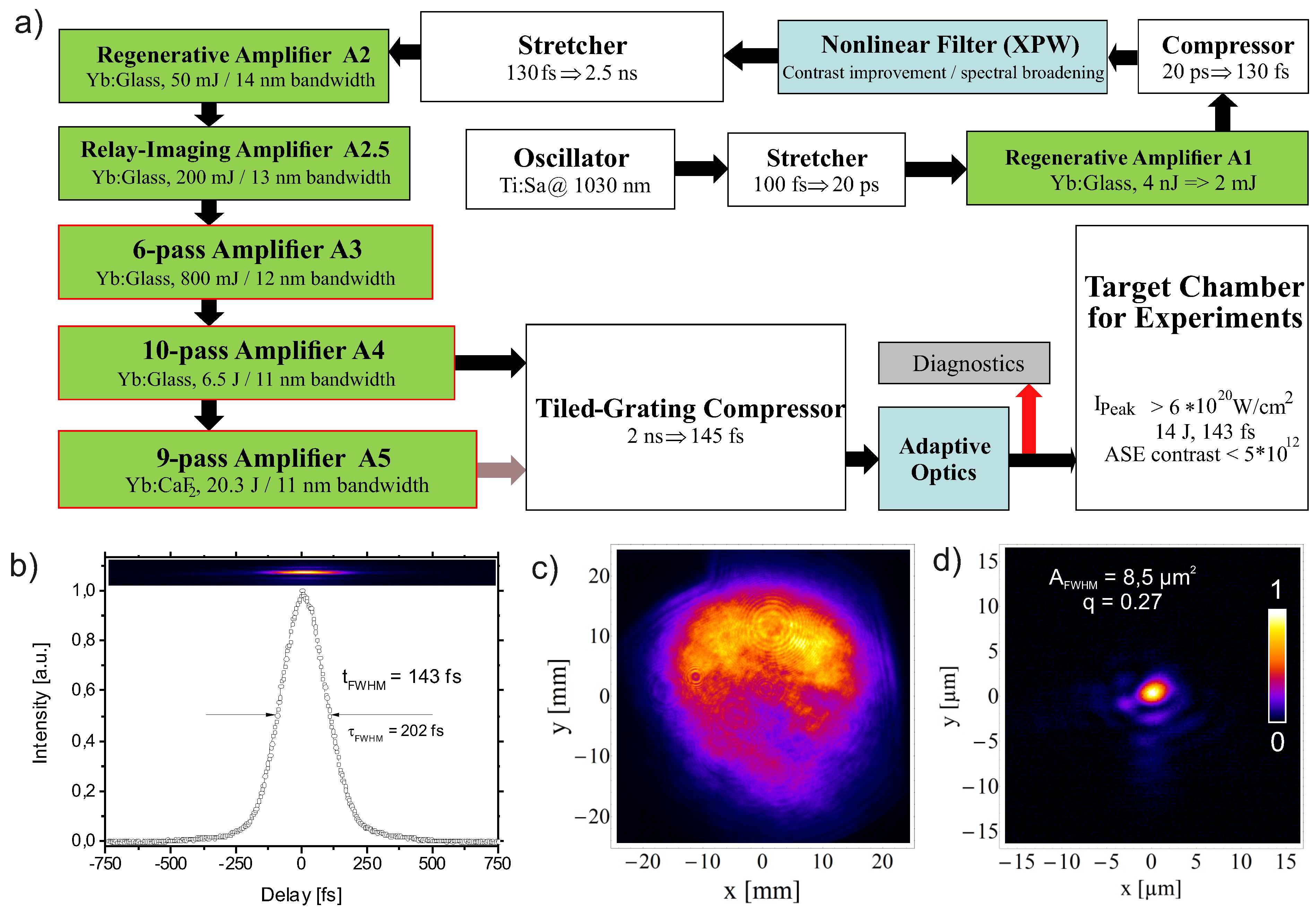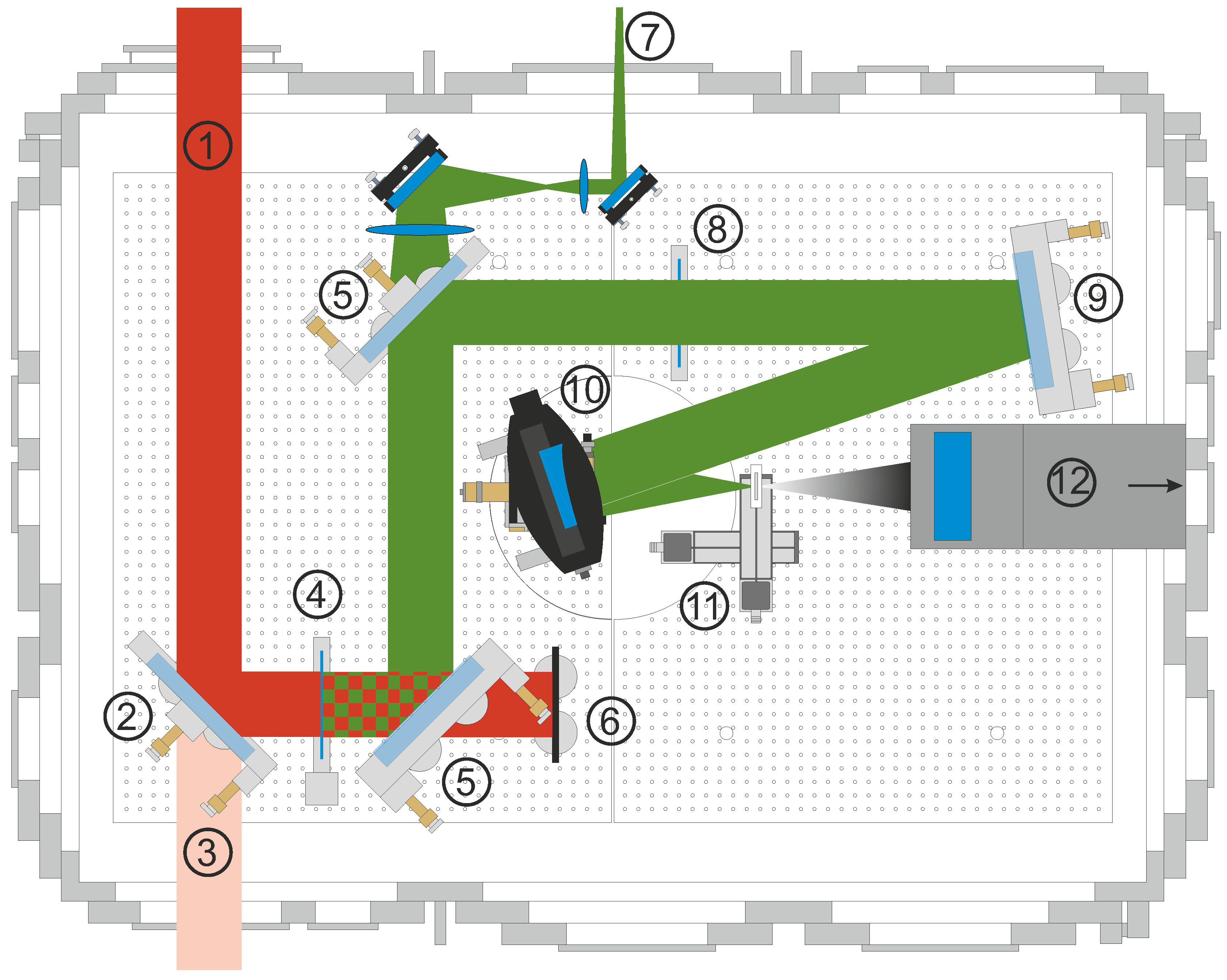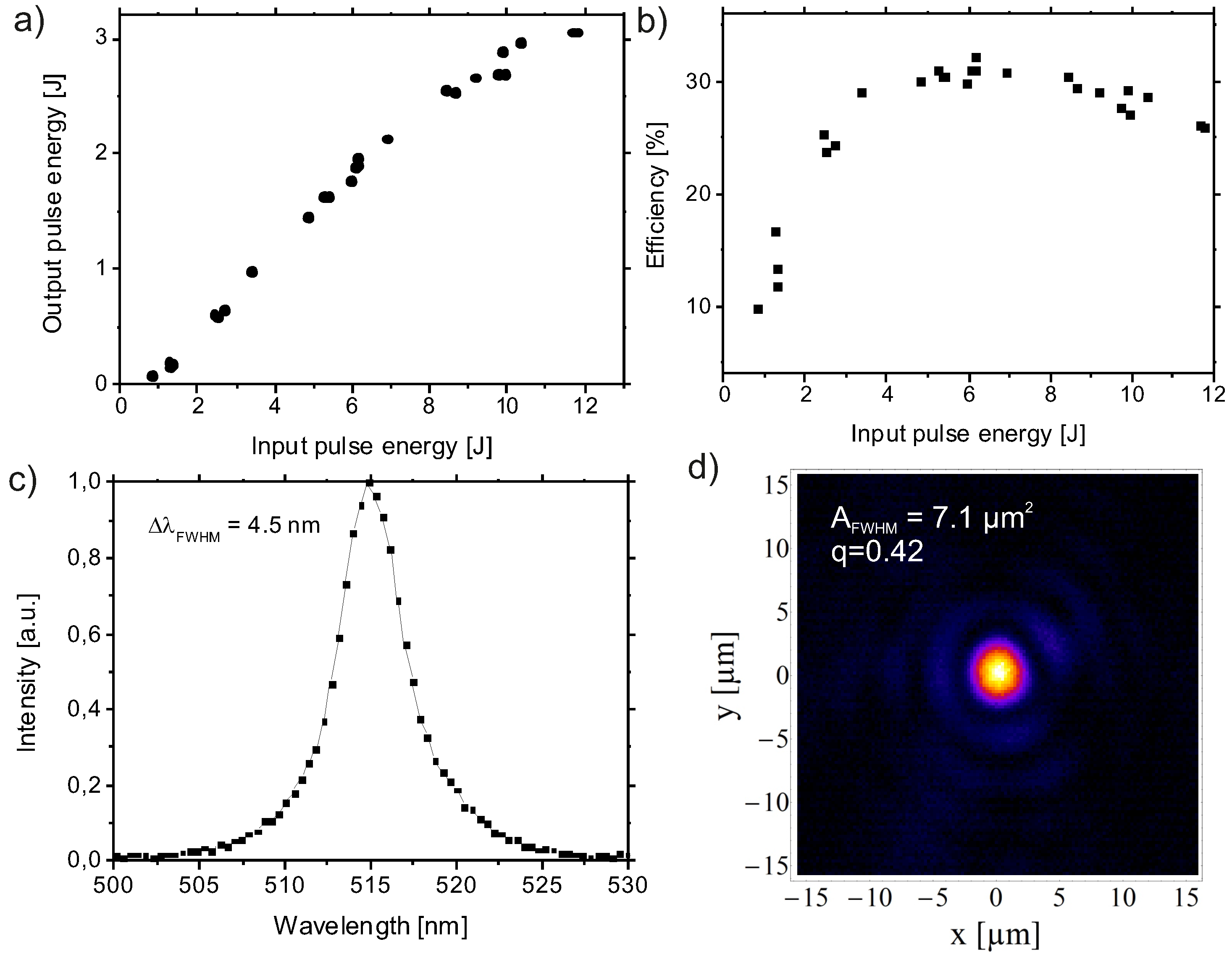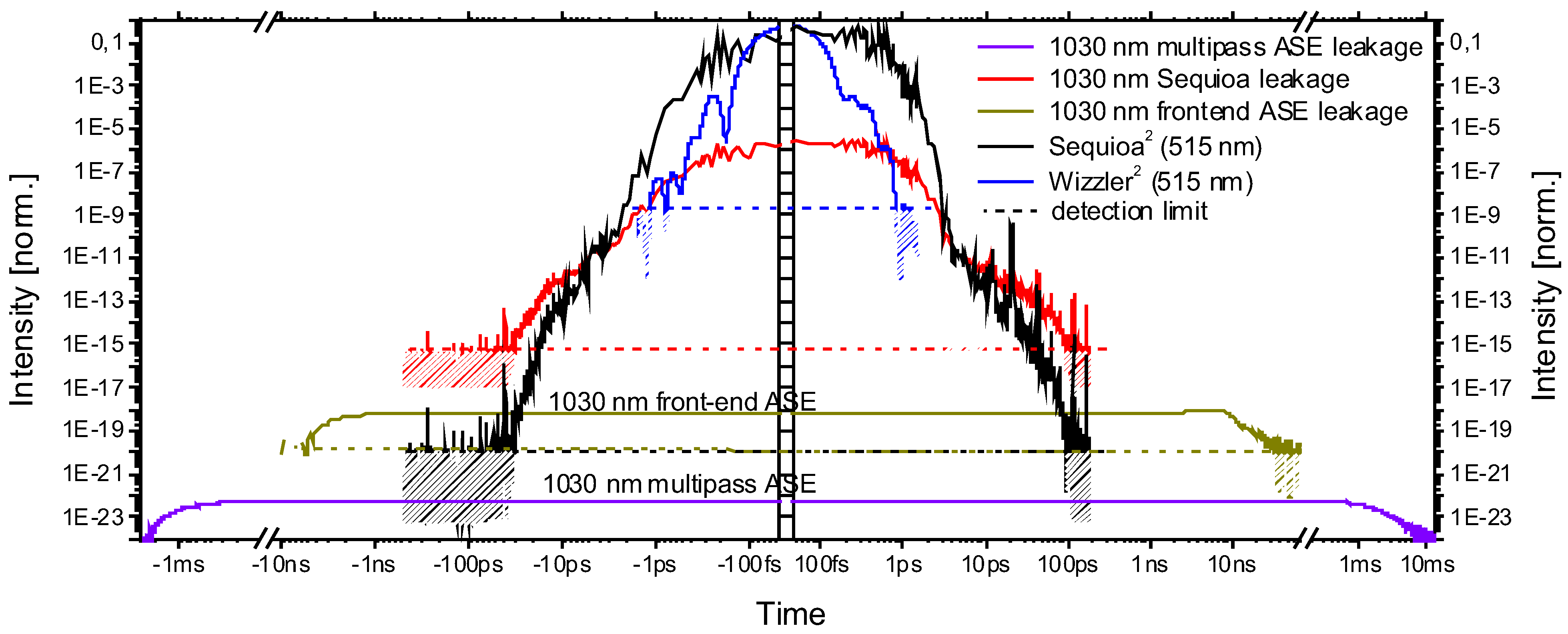Generation of 25-TW Femtosecond Laser Pulses at 515 nm with Extremely High Temporal Contrast
Abstract
:1. Introduction
2. Experimental Section

2.1. SHG Setup

3. Results and Discussion

Temporal Pulse Structure

4. Conclusions
Acknowledgments
Author Contributions
Conflicts of Interest
References
- Danson, C.; Hillier, D.; Hopps, N.; Neely, D. Petawatt class lasers worldwide. HP Laser Sci. Eng. 2015, 3, e3. [Google Scholar] [CrossRef]
- Esarey, E.; Schroeder, C.B.; Leemans, W.P. Physics of laser-driven plasma-based electron accelerators. Rev. Mod. Phys. 2009, 81, 1229–1285. [Google Scholar] [CrossRef]
- Kim, H.T.; Pae, K.H.; Cha, H.J.; Kim, I.J.; Yu, T.J.; Sung, J.H.; Lee, S.K.; Jeong, T.M.; Lee, J. Enhancement of Electron Energy to the Multi-GeV Regime by a Dual-Stage Laser-Wakefield Accelerator Pumped by Petawatt Laser Pulses. Phys. Rev. Lett. 2013, 111, 165002–165006. [Google Scholar] [CrossRef] [PubMed]
- Macchi, A.; Borghesi, M.; Passoni, M. Ion acceleration by superintense laser-plasma interaction. Rev. Mod. Phys. 2013, 85, 751–793. [Google Scholar] [CrossRef]
- Corde, S.; Phuoc, K.T.; Beck, A.; Lambert, G.; Fitour, R.; Lefebvre, E.; Malka, V.; Rousse, A. Femtosecond x-rays from laser-plasma accelerators. Rev. Mod. Phys. 2013, 85, 1–58. [Google Scholar] [CrossRef]
- Izawa, Y.; Miyanaga, N.; Kawanaka, J.; Yamakawa, K. High Power Lasers and Their New Applications. J. Opt. Soc. Korea 2008, 12, 178–185. [Google Scholar] [CrossRef]
- Johnston, H. Five spin-offs from physics research with the potential to change our lives: Physics for our future. Phys. World 2013, 26, 50–53. [Google Scholar] [CrossRef]
- Keppler, S.; Sävert, A.; Körner, J.; Liebetrau, H.; Hornung, M.; Hein, J.; Kaluza, M.C. The generation of amplified spontaneous emission in high-power CPA laser systems. Laser Photonics Rev. 2015. [Google Scholar] [CrossRef]
- Danson, C.; Neely, D.; Hillier, D. Pulse fidelity in ultra-high-power (petawatt class) laser systems. HP Laser Sci. Eng. 2014, 2, e34. [Google Scholar] [CrossRef]
- Hornung, M.; Liebetrau, H.; Seidel, A.; Keppler, S.; Kessler, A.; Körner, J.; Hellwing, M.; Schorcht, F.; Klöpfel, D.; Arunachalam, A.K.; et al. The all-diode-pumped laser system POLARIS—An experimentalist’s tool generating ultra-high contrast pulses with high energy. HP Laser Sci. Eng. 2014, 2, e20. [Google Scholar] [CrossRef]
- Itatani, J.; Faure, J.; Nantel, M.; Mourou, G.; Watanabe, S. Suppression of the amplified spontaneous emission in chirped-pulse-amplification lasers by clean high-energy seed-pulse injection. Opt. Commun. 1998, 148, 70–74. [Google Scholar] [CrossRef]
- Yoshida, H.; Ishii, E.; Kodama, R.; Fujita, H.; Kitagawa, Y.; Izawa, Y.; Yamanaka, T. High-power and high-contrast optical parametric chirped pulse amplification in β-BaB2O4 crystal. Opt. Lett. 2003, 28, 257–259. [Google Scholar] [CrossRef] [PubMed]
- Kalashnikov, M.P.; Risse, E.; Schönnagel, H.; Sandner, W. Double chirped-pulse-amplification laser: A way to clean pulses temporally. Opt. Lett. 2005, 30, 923–925. [Google Scholar] [CrossRef] [PubMed]
- Jullien, A.; Albert, O.; Burgy, F.; Hamoniaux, G.; Rousseau, J.P.; Chambaret, J.P.; Auge-Rochereau, F.; Cheriaux, G.; Etchepare, J.; Minkovski, N.; et al. 1010 temporal contrast for femtosecond ultraintense lasers by cross-polarized wave generation. Opt. Lett. 2005, 30, 920–922. [Google Scholar] [CrossRef] [PubMed]
- Kiriyama, H.; Mori, M.; Pirozhkov, A.S.; Ogura, K.; Sagisaka, A.; Kon, A.; Esirkepov, T.Z.; Hayashi, Y.; Kotaki, H.; Kanasaki, M.; et al. High-Contrast, High-Intensity Petawatt-Class Laser and Applications. IEEE J. Sel. Topics Quantum Electron. 2015, 21, Article No. 1601117. [Google Scholar] [CrossRef]
- Schreiber, J.; Bell, F.; Najmudin, Z. Optimization of relativistic laser-ion acceleration. HP Laser 2014, 2, e41. [Google Scholar] [CrossRef]
- Kapteyn, H.C.; Murnane, M.M.; Szoke, A.; Falcone, R.W. Prepulse energy suppression for high-energy ultrashort pulses using self-induced plasma shuttering. Opt. Lett. 1992, 16, 490–492. [Google Scholar] [CrossRef]
- Reed, S.A.; Matsuoka, T.; Bulanov, S.; Tampo, M.; Chvykov, V.; Kalintchenko, G.; Rousseau, P.; Yanovsky, V.; Kodama, R.; Litzenberg, D.W.; et al. Relativistic plasma shutter for ultraintense laser pulses. Appl. Phys. Lett. 2009, 94, Article No. 201117. [Google Scholar] [CrossRef] [PubMed]
- Chien, C.Y.; Korn, G.; Coe, J.S.; Squier, J.; Mourou, G.; Craxton, R.S. Highly efficient second-harmonic generation of ultraintense Nd: Glass laser pulses. Opt. Lett. 1995, 20, 353–355. [Google Scholar] [CrossRef] [PubMed]
- Queneuille, J.; Druon, F.; Maksimchuk, A.; Cheriaux, G.; Mourou, G.; Nemoto, K. Second-harmonic generation and wave-front correction of a terawatt laser system. Opt. Lett. 2000, 25, 508–510. [Google Scholar] [CrossRef] [PubMed]
- Hillier, D.; Danson, C.; Duffield, S.; Egan, D.; Elsmere, S.; Girling, M.; Harvey, E.; Hopps, N.; Norman, M.; Parker, S.; et al. Ultrahigh contrast from a frequency-doubled chirped-pulse-amplification beamline. Appl. Opt. 2013, 52, 4258–4263. [Google Scholar] [CrossRef] [PubMed]
- Liebetrau, H.; Hornung, M.; Seidel, A.; Hellwing, M.; Kessler, A.; Keppler, S.; Schorcht, F.; Hein, J.; Kaluza, M.C. Ultra-high contrast frontend for high peak power fs-lasers at 1030 nm. Opt. Express 2014, 22, 24776–24786. [Google Scholar] [CrossRef] [PubMed]
- Kessler, A.; Hornung, M.; Keppler, S.; Schorcht, F.; Hellwing, M.; Liebetrau, H.; Körner, J.; Sävert, A.; Siebold, M.; Schnepp, M.; et al. 16.6 J chirped femtosecond laser pulses from a diode-pumped Yb:CaF2 amplifier. Opt. Lett. 2014, 39, 1333–1336. [Google Scholar] [CrossRef] [PubMed]
- Ditmire, T.; Rubenchik, A.M.; Eimerl, D.; Perry, M.D. Effects of cubic nonlinearity on frequency doubling of high-power laser pulses. JOSA B 1996, 13, 649–655. [Google Scholar] [CrossRef]
- Keppler, S.; Hornung, M.; Bödefeld, R.; Sävert, A.; Liebetrau, H.; Hein, J.; Kaluza, M.C. Full characterization of the amplified spontaneous emission from a diode-pumped high-power laser system. Opt. Express 2014, 22, 11228–11235. [Google Scholar] [CrossRef] [PubMed]
© 2015 by the authors; licensee MDPI, Basel, Switzerland. This article is an open access article distributed under the terms and conditions of the Creative Commons Attribution license (http://creativecommons.org/licenses/by/4.0/).
Share and Cite
Hornung, M.; Becker, G.A.; Seidel, A.; Reislöhner, J.; Liebetrau, H.; Bock, L.; Keppler, S.; Kessler, A.; Zepf, M.; Hein, J.; et al. Generation of 25-TW Femtosecond Laser Pulses at 515 nm with Extremely High Temporal Contrast. Appl. Sci. 2015, 5, 1970-1979. https://doi.org/10.3390/app5041970
Hornung M, Becker GA, Seidel A, Reislöhner J, Liebetrau H, Bock L, Keppler S, Kessler A, Zepf M, Hein J, et al. Generation of 25-TW Femtosecond Laser Pulses at 515 nm with Extremely High Temporal Contrast. Applied Sciences. 2015; 5(4):1970-1979. https://doi.org/10.3390/app5041970
Chicago/Turabian StyleHornung, Marco, Georg Alexander Becker, Andreas Seidel, Jan Reislöhner, Hartmut Liebetrau, Lennart Bock, Sebastian Keppler, Alexander Kessler, Matthew Zepf, Joachim Hein, and et al. 2015. "Generation of 25-TW Femtosecond Laser Pulses at 515 nm with Extremely High Temporal Contrast" Applied Sciences 5, no. 4: 1970-1979. https://doi.org/10.3390/app5041970
APA StyleHornung, M., Becker, G. A., Seidel, A., Reislöhner, J., Liebetrau, H., Bock, L., Keppler, S., Kessler, A., Zepf, M., Hein, J., & Kaluza, M. C. (2015). Generation of 25-TW Femtosecond Laser Pulses at 515 nm with Extremely High Temporal Contrast. Applied Sciences, 5(4), 1970-1979. https://doi.org/10.3390/app5041970







